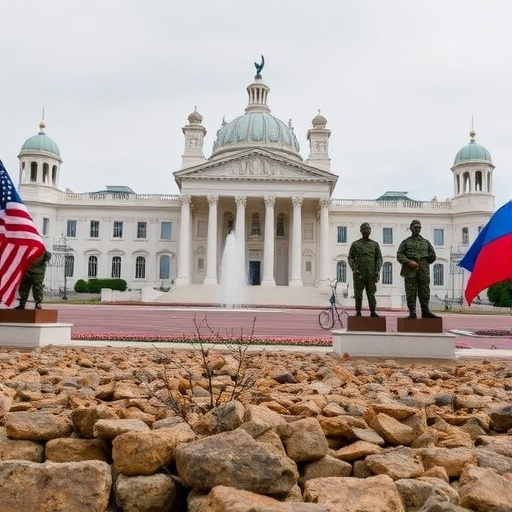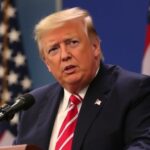U.S. Imposes Harsh New Sanctions on Russia as Ukraine Conflict Fuels Diplomatic Standoff
In a bold escalation of its strategy against Moscow’s aggression, the U.S. government unveiled a sweeping package of Sanctions targeting Russia’s financial sector, energy giants, and high-profile oligarchs on Wednesday. This move, announced by the Treasury Department amid the intensifying Ukraine conflict, aims to squeeze Russia’s war machine by restricting access to global markets and freezing assets worth billions. As diplomatic tensions reach a boiling point, critics and supporters alike debate whether these measures will finally force a shift in Russia’s stance or merely prolong the economic pain for ordinary citizens.
U.S. Targets Russia’s Economic Lifelines in Fresh Sanctions Wave
The latest sanctions, building on measures imposed since Russia’s full-scale invasion of Ukraine in February 2022, zero in on key pillars of the Russian economy. According to a statement from Treasury Secretary Janet Yellen, the U.S. is designating over a dozen major Russian banks, including Sberbank’s international subsidiaries, as primary targets. These institutions, which handle roughly 70% of Russia’s domestic payments, will face immediate disconnection from the SWIFT messaging system, severely hampering international transactions.
Energy remains a flashpoint, with the U.S. government expanding restrictions on entities like Gazprom and Rosneft. New prohibitions ban American firms from providing technology and services that support Russia’s oil exports, potentially slashing the country’s revenue by an estimated $10 billion annually, per analysts at the Institute for International Economics. Oligarchs close to President Vladimir Putin, such as aluminum magnate Oleg Deripaska and steel tycoon Viktor Rashnikov, have their yachts, private jets, and luxury properties in the U.S. seized or frozen, adding to a list of over 1,000 sanctioned individuals since the conflict began.
Statistics underscore the scale: The U.S. has now sanctioned more than 2,500 Russian entities, contributing to a 40% drop in Russia’s GDP growth projections for 2023, according to the International Monetary Fund. “These sanctions are designed to degrade Russia’s ability to fund its illegal war,” Yellen emphasized in a press briefing. “We’re not just hitting symbols; we’re striking at the heart of their financial resilience.”
Contextually, this package follows a series of European Union and G7-aligned actions, but the U.S. leads in scope, leveraging its dominance in the dollar-based global financial system. Diplomats note that while previous rounds slowed Russia’s military logistics, these target evasion tactics like third-party trading through countries such as Turkey and India.
Kremlin’s Defiant Response Signals No Backing Down
Russia wasted no time in firing back, with Kremlin spokesperson Dmitry Peskov labeling the U.S. sanctions as “economic terrorism” aimed at undermining global stability. In a televised address, President Putin vowed retaliatory measures, including potential bans on Western imports and further militarization of energy infrastructure. “The West’s aggression will only strengthen our resolve,” Putin stated, echoing themes from his May 9 Victory Day speech where he framed the Ukraine conflict as an existential battle against NATO expansion.
The Russian Foreign Ministry announced immediate countermeasures, such as expelling U.S. diplomats and restricting American NGOs operating in Russia. Economically, Moscow is accelerating its pivot to BRICS partners—Brazil, India, China, and South Africa—for trade alternatives. Data from Russia’s Central Bank shows a 25% increase in ruble-denominated deals with China in the first quarter, mitigating some sanction impacts. Yet, inflation has surged to 12%, and the black market for Western goods thrives in cities like Moscow and St. Petersburg.
Diplomatic channels, already strained, saw a terse exchange at the United Nations, where Russia’s ambassador accused the U.S. of hypocrisy in its foreign policy. Quotes from independent Russian analysts, like economist Sergei Aleksashenko, highlight internal fractures: “These sanctions hurt the elite, but the public bears the brunt, fueling domestic discontent.” Peskov dismissed such views, insisting that Russia’s $600 billion in foreign reserves provide a buffer against prolonged pressure.
Global Ripples: Energy Prices Soar and Supply Chains Strain
The sanctions’ fallout extends far beyond U.S.-Russia borders, igniting volatility in global energy markets and complicating supply chains worldwide. With Russia supplying 40% of Europe’s natural gas pre-conflict, the latest measures have pushed Brent crude oil prices above $90 per barrel, a 15% spike in the past week alone, according to Bloomberg data. European consumers face winter heating bills up 30%, prompting emergency EU summits in Brussels.
In the U.S., gasoline prices have climbed to $3.80 per gallon nationally, drawing fire from domestic critics who argue the policy exacerbates inflation. The conflict’s shadow looms large: Ukraine reports over 100,000 civilian casualties since 2022, with sanctions intended to curb Russia’s artillery production, which relies on imported semiconductors now blocked by U.S. export controls.
Business leaders are reeling. A survey by the U.S. Chamber of Commerce reveals that 60% of American exporters to Russia have halted operations, leading to $15 billion in lost revenue. Meanwhile, Asian markets like India have boosted Russian oil imports by 80%, navigating sanctions via rupee-ruble swaps. Environmental advocates praise the measures for potentially reducing global emissions by curbing Russian fossil fuel dominance, but warn of short-term spikes in coal usage elsewhere.
Quotes from industry insiders add depth: ExxonMobil CEO Darren Woods noted in an earnings call, “Sanctions disrupt our joint ventures, but compliance is non-negotiable amid this diplomacy crisis.” The broader conflict narrative includes stalled peace talks in Geneva, where U.S. envoys push for sanctions relief tied to territorial concessions— a non-starter for Moscow.
Analysts Debate: Will Sanctions Bend Russia’s Will or Backfire?
As the U.S. government doubles down on sanctions, a chorus of experts questions their long-term efficacy in resolving the Ukraine conflict. Proponents, including former National Security Advisor Fiona Hill, argue that cumulative pressure has already forced Russia to ration military spending, with defense budgets strained by 20% due to import shortages. “Sanctions aren’t a silver bullet, but they’re eroding the Kremlin’s war chest,” Hill said in a CNN interview.
Skeptics, however, point to Russia’s adaptation strategies. Think tank reports from the Carnegie Endowment for International Peace estimate that while GDP has contracted 2.1% this year, parallel imports via Central Asia have sustained key sectors. Political scientist Angela Stent warns of blowback: “Escalating sanctions risks pushing Russia deeper into China’s orbit, altering global diplomacy dynamics.”
Public opinion polls reflect division. A Pew Research Center survey shows 65% of Americans support tougher measures against Russia, up from 55% in 2022, but only 40% believe they’ll end the conflict soon. In Europe, German Chancellor Olaf Scholz faces domestic pushback, with farmers protesting higher fertilizer costs linked to sanctioned Russian potash exports.
Historical context bolsters the debate: U.S. sanctions on Iran since 2018 reduced oil exports by 80%, yet nuclear talks persist. Applied to Russia, experts like those at the Atlantic Council predict a similar stalemate unless paired with military aid to Ukraine, which has received $50 billion from the U.S. since the invasion.
Path Forward: Escalation Risks and Hopes for De-Escalation
Looking ahead, the U.S. sanctions signal a commitment to sustained pressure, with White House officials hinting at further rounds if Russia advances in eastern Ukraine. Diplomatic overtures, though faint, include backchannel talks via Turkey, where mediators propose grain export corridors to ease global food prices—Russia’s blockade has driven wheat costs up 25% worldwide.
Implications for global security are profound. NATO’s expansion, with Finland and Sweden’s recent accessions, has heightened Moscow’s paranoia, potentially prolonging the conflict. Economists forecast that without resolution, sanctions could cost the world economy $1.5 trillion by 2025, per World Bank projections.
Yet, glimmers of progress emerge: Ukraine’s counteroffensives, bolstered by Western arms, have reclaimed 50% of occupied territories, pressuring Russia internally. As the U.S. government navigates this tightrope, the onus falls on multilateral diplomacy to translate economic isolation into peace talks. Stakeholders watch closely, knowing that missteps could ignite broader confrontations in an already volatile geopolitical landscape.








